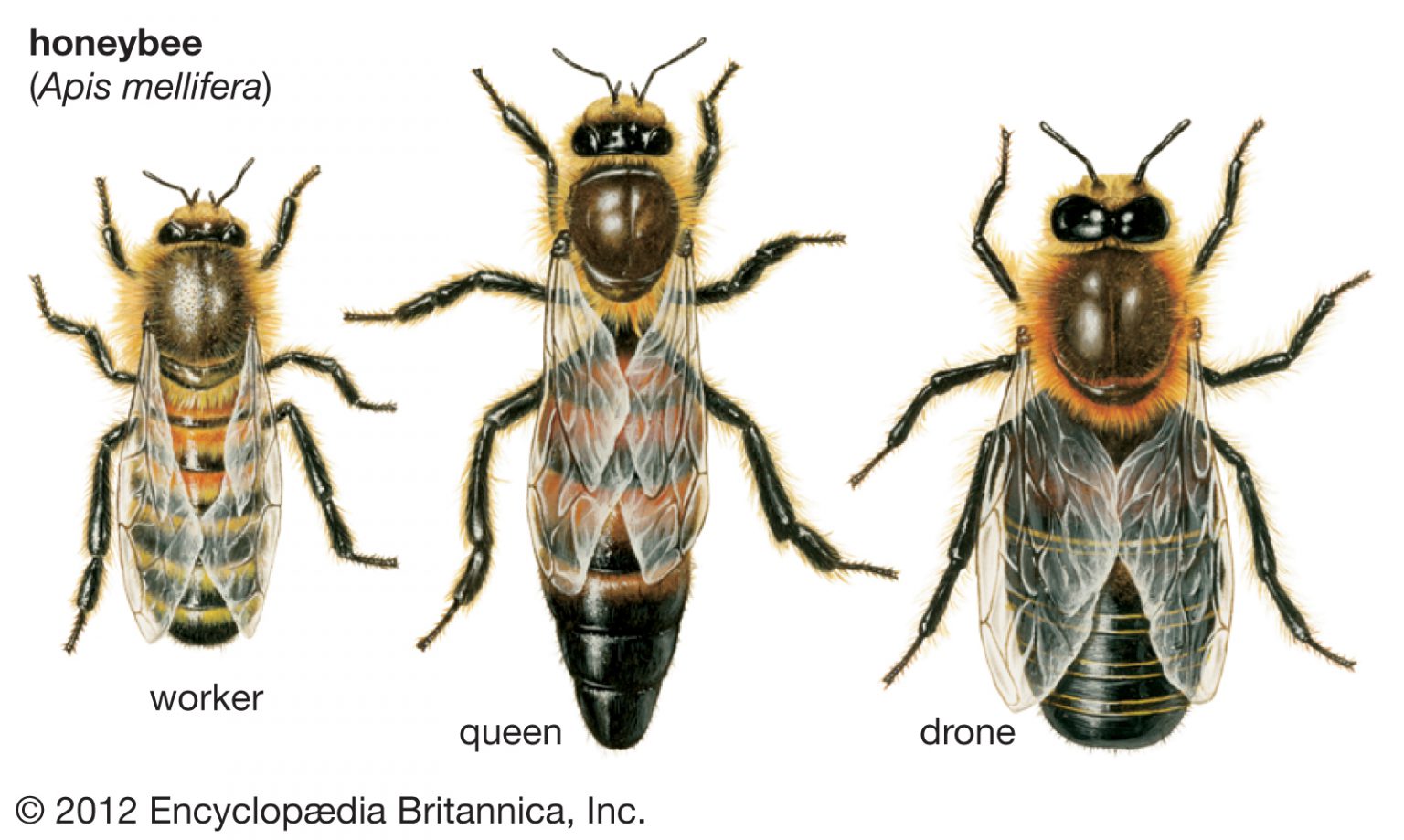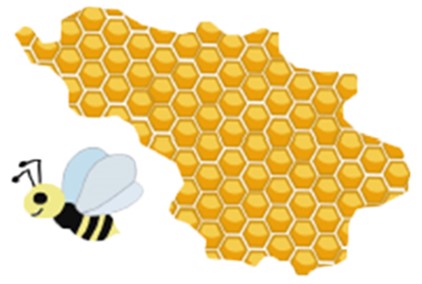The Drone Bee

What are honey bee drones?
A drone, the male bee, is produced from an unfertilized egg that has half the chromosomes, 16, of a worker bee who has 32 chromosomes. The drone has no father but does have a grandfather, as his mother, the queen, was produced from a fertilized egg. This system of reproduction is known as parthenogenesis.
A queen becomes an adult in 16 days, a worker in 21 days, and a drone in 24 days.
Drones are the largest bees in the colony. Drones eat three times as much food as workers. An excessive number of drones, in the hive, will place a burden on the colony’s food supply and worker bees.
For the first 3 days of adulthood they are feed by the workers (female) bees. Only after day 4 they can feed themselves. When they are 8 days old, they leave the hive to take their first orientation flight, usually between 11:00 AM and 5:00PM.

How long does a drone live?
A drone reaches sexual maturity at approximately day 12 of his adulthood. His life span can end when he mates with a virgin queen from another hive or, can live until fall, when most of the drones are escorted out of the hive by the worker bees. Since mating usually takes place in the late spring and summer, drones are not needed and are a strain on hive resources. Therefore, they are not needed in the hive and escorted out to die of starvation and cold. In families with no queen, or with unmated or older queens, drones are tolerated over the winter.
Drones’ jobs
Drones only function to the hive is to mate with a virgin queen. All the other duties, such as collecting nectar and pollen, clean the hive, feed the larvae, and protect the hive are performed by the workers. While they do contribute to heating and ventilation of the hive, they also increase the risks of introducing viruses and mites since they are in contact with drone from other hives.

Physical traits
– They are the largest bees in the hive.
– Their length is of approx. 15-18 mm, weighing between 200 and 280 mg (most commonly 230 mg)
– Their head is larger than that of either the queen or worker, with a round shape while a worker’s and queen’s head is triangular shaped.
– The antennas have a joint in addition to those of worker bees
– Their compound eyes meet at the top of their head. These larger eyes are help them spot the queens during mating flights. (Mating with a queen is performed in flight only.)
– They have a short proboscis, so they cannot lap the floral nectar. Instead, it allows them to receive food from worker bees or feed themselves.
– Drones emit a pheromone, an airborne chemical messenger, which is diffused in the air during flights that attracts virgin queens to the mating areas. These mating areas are called Drone Congregation Area.
– Drones have NO STINGER, no pollen baskets, no wax glands.
– The eyes of the male meet on top of their head. A drone’s head is like an eyed sphere.
For more information on the weight and size of the honey bee: Worker size in honeybees and its relationship with season and foraging distance
Drone congregation area
A drone congregation area (DCA) is a specific place where male honey bees gather and wait for virgin queens to visit. All honey bee mating takes place in these areas—never on the ground or in the hive.
These congregation areas bring drones and queens together from a wide area, guarding against inbreeding. A comprehensive study in Germany found that a single DCA could contain drones from up to 240 different colonies. Another study found that a DCA could contain anywhere from several hundred to 30,000 drones. The large number assures that adequate gene mixing takes place.
Estimates vary, but most drone congregation areas are from 5 to 35 meters (16 to 115 feet) above the ground, and measure from 30 to 200 meters (100 to 650 feet) across. The shape is somewhat like a traffic cone, wide at the bottom and narrow at the top.
Oddly enough, drone congregation areas reappear in the same location year after year even though the drones live only a few weeks and the queens mate a few days after emerging from their cell. Something other than memory enables the newly hatched drones to find an established area. Some researchers think that certain geographical features or vegetation patterns may signal a favorable spot—one which gets selected over successive years. In addition, some think that a male pheromone may attract males to each other, allowing them to coalesce in large numbers.
Multiple drone congregation areas may be found wherever honey bee colonies exist. Drones may fly between these areas on established routes known as flyways. A drone can fly from one DCA to another, trying his luck in different locations. From below, an active DCA sounds something like a swarm.
How the system works
Drones become sexually mature approximately 12 days after emergence. During that time, the drones consume pollen and nectar, building their strength and their sperm reserves. Toward the end of the maturing process, the drones take occasional orientation flights to learn the location of their hives.
Once mature, mating flights begin. The drones choose sunny afternoons to make their flights, usually between 3 and 5 pm local time. If they are unsuccessful at mating, each flight will last about 10 to 40 minutes. Between flights, the drones return to their hive (or to one nearby) to rest and refuel before going out again. Time and weather permitting, the drones may take up to four flights per day lasting for approximately 4 hours during peak mating season and 2 and a half hours near the end.
Drones choose a congregation area that is relatively close to their own hive. But queens travel greater distances, perhaps 2 or 3 miles to a DCA. This is yet another way that young queens are kept from mating with their brothers.
Mating with a virgin queen
As a receptive queen enters the congregation area, a comet-shaped drift (a group) of drones follows her, attracted by the scent of her pheromones. The comet may contain up to 100 hopeful drones.
The large compound eyes on the top of the drones’ head allow them to follow her every move. In true competitive fashion, the fastest and most agile drone is the first to mate. It takes but a moment, and the entire romantic interlude is over in 3 to 5 seconds. Unfortunately for him, the drone dies in the process.
The queen continues this mating process 12-20 times during the next few minutes. The queen may also take multiple mating flights over the next few days. After completing these mating flight, early in her life, she never mates again.
Drone comb
While worker brood comb is usually crescent-shaped and appears in the middle of a frame, drone brood comb is located on the outside of the total comb. It is sometimes separated from the worker brood comb by a comb of feed pollen. This design places the drone comb at a more vulnerable location of freezing.
The varroa mite is a major killer of honey bee hives. Mites reproduce inside the capped brood cells of honey bees.
Mites prefer drone brood. They have more time to produce baby mites inside the cell of drone because the cells are capped longer.
Some beekeepers use special drone cell size foundation to encourage drone production and to trap mites in one place.
The sealed drone brood is removed and frozen to kill mites. This is a workable plan but it is labor intensive for the bees and the beekeeper.
Drone Brood Can Signal Trouble
In natural situations, drone brood is located clusters along the edge of the brood nest. A hive inspection should reveal a majority of worker brood with some drone brood.
Any colony with only drone brood is in big trouble. Seeing only drone cells is a sign of a lost queen bee or one that has run out of semen.
The beekeeper will need to intervene in hopes of saving the hive by providing a new queen.
Drone Brood Can Signal Trouble
In most colonies, you will only see drones in the warm season. When we see drone brood in early Spring, we know that bee swarm time is coming.
Good patterns of drone brood are actually a good sign. It shows that your bee colony is strong enough to move toward swarming.
In a normal colony, drone brood will appear in groups along the edges of the brood nest. This places them in the most vulnerable area.
If freezing temps causes the cluster to contract, drone brood will be lost rather than workers.
